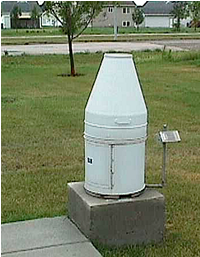|
Rainfall Gages
|
| |
| |
| Rain Gauges - Hourly Precipitation |
|

Fischer Porter Rain Gauge
-
Fischer Porter Rain Gauge: Sites reporting hourly precipitation are most likely equipped with a Fischer Porter automatic rain gauge, a white and cone-shaped gauge resembling a rocket. It stands about 5 feet tall and 2 feet in diameter. This gauge collects all types of precipitation through a hole in the top. Precipitation is continuously collected in a bucket on the inside. As the bucket grows heavier, the weight of the bucket presses down on a scale. Every 15 minutes, a "ticker tape" is punched with holes according to the weight of the bucket. The reading on the tape keeps a running tally of the amount of rainfall and snowfall (in inches, tenths, and hundredths) that has occurred since the last time the bucket was emptied.
|
-
Weighing Rain Gauge: A few sites are equipped with a Weighing Rain Gauge. Like the Fischer Porter gauge, there is a hole in the top for precipitation to fall through into a bucket inside. The bucket presses down on a scale as the precipitation accummulates. However, instead of a tape rolling through, the weight of the bucket and precipitation is recorded by pen-and-ink on a sheet of paper. The paper is mounted on a metal drum that rotates around once every 24 hours.
|
| Rain Gauge - Daily Precipitation |
|

Standard Rain Guage
-
Standard Rain Gauge: A Standard Rain Gauge (SRG) is a gauge that collect precipitation in a hollow metal tube with an open top. The opening at the top is 8 inches in diameter, the reason the SRG is sometimes also known as an "8 inch gauge". Place in a stand, the top of the gauge is about 3 feet high. During warmer months, a smaller tube (2 inches in diameter) is placed inside the larger 8 inch tube. A funnel fits on top so that the rainfall channels through the larger 8 inch opening into the smaller 2 inch diameter tube. This allows the rainfall to be measured more accurately in smaller increments. The observer uses a normal ruler to measure the depth of the water in the small tube. In the winter, the funnel and smaller tube are removed. This allows snow to fall directly into the larger 8 inch tube. The snow is melted, then poured into the smaller 2 inch diameter tube for measurement of the liquid equivalent.
|
|